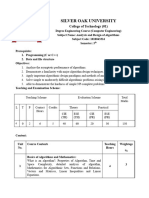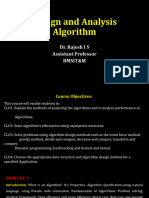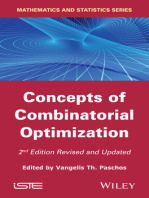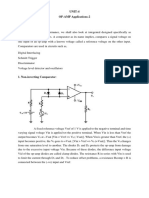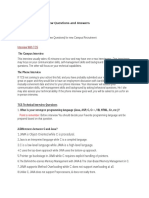0 ratings0% found this document useful (0 votes)
5 viewsDAA LAB SYllabus
Uploaded by
hdshb786Copyright
© © All Rights Reserved
Available Formats
Download as DOC, PDF, TXT or read online on Scribd
0 ratings0% found this document useful (0 votes)
5 viewsDAA LAB SYllabus
Uploaded by
hdshb786Copyright
© © All Rights Reserved
Available Formats
Download as DOC, PDF, TXT or read online on Scribd
You are on page 1/ 3
Title of Subject: DAA LAB
COURSE CODE: 23MCA35 CIE Marks: 50
SEMESTER: III SEE Marks: 50
Contact Hours: (L:T:P): 0-0-4 Credit: 02 Duration of Exam:
03
Programs offer hands-on experience with various design and analysis of algorithms
and techniques.
1. Develop a program to perform binary search on a sorted array and
evaluate its time complexity.
2. Create functions to implement quicksort algorithms and compare their
efficiency on different datasets.
3. Create functions to implement merge sort algorithms and compare their
efficiency on different datasets.
4. Solve the job sequencing problem with deadlines using a greedy approach.
5. Implement algorithms to find minimum cost spanning trees.
6. Implement algorithms to find single-source shortest paths in a graph.
7. Develop dynamic programming solutions for 0/1 knapsack problem.
8. Solve the travelling salesperson problem using dynamic programming.
9. Implement backtracking algorithms to solve the n-queen problem.
10. Implement Hamiltonian Cycles in a connected undirected Graph G of n
vertices using the backtracking principle.
Scheme of Continuous Internal Evaluation Laboratory (CIE): 25 + 25 = 50
Conduction of laboratory exercises, Lab report & observation & analysis, Lab
Test: TWO LAB tests will be conducted. Each LAB test will be evaluated for 25
Marks.
Scheme of Semester End Examination (SEE) Laboratory for 50 marks:
SEE for practical will be jointly conducted and evaluated by two examiners. The
duration of practical examination is 3 hours and is evaluated for 50 marks. The
break up for conduction of practical examination is (i) Procedure and Write up :
20% of max marks, (ii) Conducting the
practical: 60% of max marks, (iii) Viva Voce: 20% of max marks
Title of Subject: DESIGN AND ANALYSIS OF
ALGORITHM
COURSE CODE: 23MCA31 CIE Marks: 50
SEMESTER: III SEE Marks: 50 Total Hours: 50
Contact Hours: (L:T:P): 4-0-0 Credit: 04 Duration of Exam:
03
Course Outcomes: At the end of the course, the student will be able to
1. Provide understanding of fundamental algorithmic concepts and analysis
techniques, including time and space complexity, and asymptotic notations.
2. Introduction to the greedy algorithmic technique and its applications in
optimization problems like job sequencing, knapsack, minimum spanning
trees, and shortest path problems.
3. Dynamic programming methodology for solving optimization problems such
as matrix chain multiplication, knapsack, shortest path, and travelling
salesperson problems.
4. Implement backtracking and branch and bound algorithms to solve
combinatorial optimization problems like n-queens, sum of subsets, graph
colouring, and Hamiltonian cycles.
5. Computational complexity theory by introducing NP-hard and NP-complete
problems, non-deterministic algorithms, and approximation algorithms for
effective problem-
solving.
MODULE – I: Introduction 10 Hours
Algorithm, analysis, time complexity and space complexity, O-notation, Omega
notation and Theta notation. Mathematical Analysis of Recursive and Non-recursive
methods.
Divide and Conquer: General Strategy, Binary Search, Quick Sort and Merge Sort
MODULE – II: Greedy method 10 Hours
General method, applications - Job sequencing with deadlines, knapsack problem,
Minimum
cost spanning trees, Single source shortest path problem.
MODULE – III: Dynamic Programming 10 Hours
General method, applications-Matrix chain multiplication, Optimal binary search
trees, 0/1 knapsack problem, All pairs shortest path problem, Travelling sales
person problem, Reliability
design.
MODULE – IV: Backtracking 10 Hours
General method, applications-n-queen problem, sum of subsets problem, graph
coloring, Hamiltonian cycles. Branch and Bound: General method, applications -
Travelling sales person problem,0/1 knapsack problem- LC Branch and Bound
solution, FIFO Branch and Bound
solution.
MODULE – V: NP-Hard and NP-Complete problems 10 Hours
Basic concepts, non-deterministic algorithms, NP - Hard and NP Complete
classes, Cook’s
theorem.
Text Books:
Author Names Name of the Text Books Editio Publisher
n
Ellis Horowitz, Fundamentals of Galgotia
-
Satraj Sahni, Computer Algorithms Publications
Rajasekharam Pvt.
You might also like
- Shin-Nippon SLM-4000-5000 - Service Manual PDFNo ratings yetShin-Nippon SLM-4000-5000 - Service Manual PDF46 pages
- Métodos numéricos aplicados a Ingeniería: Casos de estudio usando MATLABFrom EverandMétodos numéricos aplicados a Ingeniería: Casos de estudio usando MATLAB5/5 (1)
- Cs816: Design and Analysis of Algorithms (Daa) : (Professional Elective-I For M.Tech CSE)No ratings yetCs816: Design and Analysis of Algorithms (Daa) : (Professional Elective-I For M.Tech CSE)1 page
- SRM - b.tech-15CS204J-algorithm-design-and-analysis-1No ratings yetSRM - b.tech-15CS204J-algorithm-design-and-analysis-14 pages
- 20MCA203 Design & Analysis of Algorithms Core 3 1 0 4: 3/2/1: High/Medium/LowNo ratings yet20MCA203 Design & Analysis of Algorithms Core 3 1 0 4: 3/2/1: High/Medium/Low7 pages
- 20MCA203 Design & Analysis of Algorithms Core 3 1 0 4: 3/2/1: High/Medium/LowNo ratings yet20MCA203 Design & Analysis of Algorithms Core 3 1 0 4: 3/2/1: High/Medium/Low7 pages
- 20MCA203 Design & Analysis of Algorithms Core 3 1 0 4: 3/2/1: High/Medium/LowNo ratings yet20MCA203 Design & Analysis of Algorithms Core 3 1 0 4: 3/2/1: High/Medium/Low7 pages
- BCA V and VI Sem Syllabus-As per UOM_Revised_08_04_24No ratings yetBCA V and VI Sem Syllabus-As per UOM_Revised_08_04_2430 pages
- 2ceit402 Design and Analysis of Algorithms Ce It CeaiNo ratings yet2ceit402 Design and Analysis of Algorithms Ce It Ceai2 pages
- Gujarat Technological University: 1. Teaching and Examination SchemeNo ratings yetGujarat Technological University: 1. Teaching and Examination Scheme3 pages
- Cse-305: Analysis and Design of Algorithms B. Tech Semester - V (Computer Sc. & Engg.)No ratings yetCse-305: Analysis and Design of Algorithms B. Tech Semester - V (Computer Sc. & Engg.)1 page
- Mathematics For Senior Phase Booklet Grades 7 9No ratings yetMathematics For Senior Phase Booklet Grades 7 9126 pages
- Design Calculations For Pressure VesselsNo ratings yetDesign Calculations For Pressure Vessels54 pages
- 1U Switching Power Supplies: InstallationNo ratings yet1U Switching Power Supplies: Installation2 pages
- Science Process Skills: Observe Classify Measure Infer Predict Credits Extensions About The AuthorNo ratings yetScience Process Skills: Observe Classify Measure Infer Predict Credits Extensions About The Author21 pages
- Vectors Tensors 16 Curvilinear CoordinatesNo ratings yetVectors Tensors 16 Curvilinear Coordinates25 pages
- TCS Technical Interview Questions and Answers100% (1)TCS Technical Interview Questions and Answers11 pages
- Chapter 1 Scope of Plant Utility SystemNo ratings yetChapter 1 Scope of Plant Utility System19 pages
- Eec 324 Practice Questions With AnswersNo ratings yetEec 324 Practice Questions With Answers11 pages
- Handling Precautions: Butterfly Valves (Common To All Models)No ratings yetHandling Precautions: Butterfly Valves (Common To All Models)9 pages
- Y7 Autumn Block 5 WO1 Represent Tenths and Hundredths As Diagrams 2019No ratings yetY7 Autumn Block 5 WO1 Represent Tenths and Hundredths As Diagrams 20192 pages
- (David Matsumoto) The Handbook of Culture and Psyc (B-Ok - Xyz) PDF100% (1)(David Matsumoto) The Handbook of Culture and Psyc (B-Ok - Xyz) PDF475 pages
- Oil & Gas Industry Interview Questions Answers100% (1)Oil & Gas Industry Interview Questions Answers13 pages


























